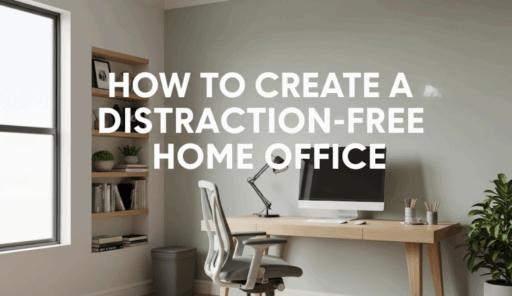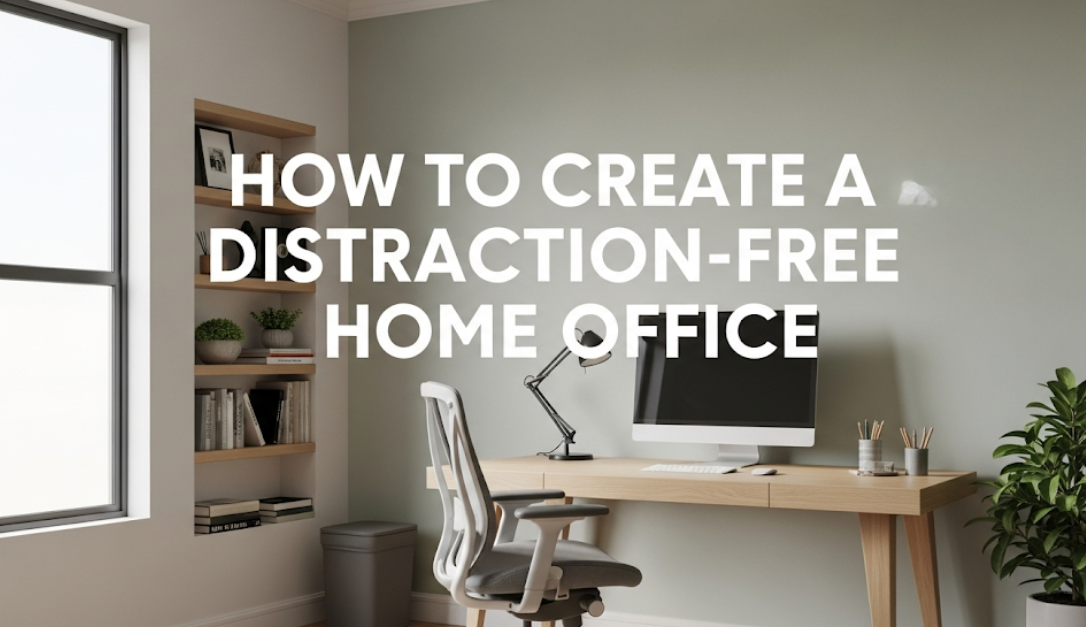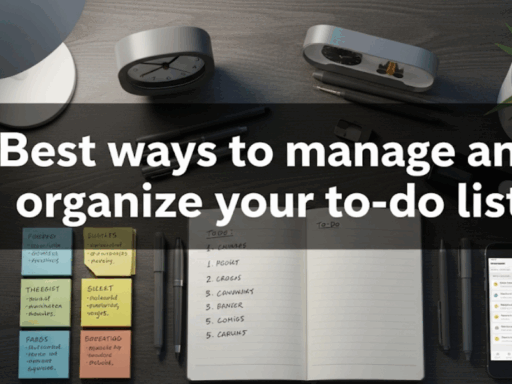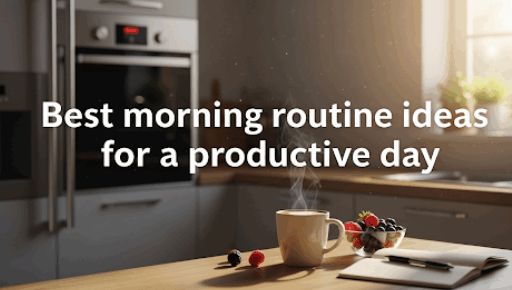The Last Guide to a Phenomenally Productive Home Office
by FateSpace Gospel
How to Deal with Productivity-Damaging Distractions
In recent times, millions of people from all over the world were forced to start working from home. Although your own home office has its upsides, it also comes with a couple of challenges of its own. The biggest hurdle? Stuff that derails your day, and leaves you feeling totally defeated!
For a distraction-free home office, you need all of that and more because it’s not enough to have the room with no noise. This is about crafting a system of resources around your mind that enables it to be fully immersed and perform at peak function for hours not minutes. From loud neighbors and family interruptions to the endless ping of notifications, here is your answer to building the ultimate work sanctuary.
This extensive guide will not only teach you how to eliminate distractions and optimize your workspace, but it will also show you how to add a boundary (or ten) around your most important asset — your focus. We’ll go over everything from picking the perfect spot to honing your concentration habits in order to turn your home office into the most productive place on earth.
Finding Your Perfect Work Zone
Location Makes All the Difference
All spaces are not created equal when it comes to productivity.
High-Traffic Areas to Avoid:
- Living rooms where family gathers
- Kitchen tables near meal prep areas
- Bedrooms that blur work-life boundaries
- Hallways with constant foot traffic
- Spaces near entertainment centers
Ideal Office Locations:
- Spare bedrooms or guest rooms
- Basement areas with good lighting
- Converted closets or nooks
- Hidden spaces, tucked away from social areas
- Home additions or garage conversions
Room Requirements Checklist
Here are the key factors you should weigh before choosing a place to set up shop:
- Windows – Mood and energy levels are raised by natural light
- Multiple Power Outlets – Not everyone has so many equipment; outlets must be available for all your equipment
- Internet Access – Good WiFi connection and responsiveness
- Sound Levels – Very low outside noise and minimal sound from other rooms
- Temperature Regulation – The ability to maintain optimum working conditions
- Privacy – Having a place where you aren’t going to get interrupted all the time
- Storage Capacity – Space for files, materials, and tools
| Location Type | Pros | Cons | Ideal For |
|---|---|---|---|
| Spare Bedroom | Sound can be dampened; Greatest opportunity for privacy | May lack natural light | Full-time remote workers |
| Living Room | Has good lighting; Furniture already exists | High traffic area; Family life distracts | Part-time/Temporary setup |
| Basement Home Office | Separate from main house; Very quiet | Limited natural lighting; May feel isolated | Focus-intensive work |
Designing Your Physical Space
Furniture That Supports Focus
Your choice of furniture will affect how well you can focus and maintain comfort during extended work sessions.
Essential Furniture Pieces:
Desk Selection Guidelines:
- Pick a size above what you need for your equipment
- Elbows should be at 90 degrees with height
- Surfaces that reduce glare and eye strain
- Add drawers and shelves for storage
- Choose a sit-stand solution for better health
Chair Investment Priorities:
- Adjustable height and armrests
- Lower back lumbar support
- Breathable fabric or mesh materials
- Wheels for easy movement
- The ability to support your weight properly
Storage Solutions:
- Filing cabinets for important documents
- Bookshelf units for reference and supplies
- Desk organizers for daily items
- Wall-mounted shelves to save floor space
- Seasonal/archival storage boxes
Lighting That Energizes
Bad lighting can lead to eye strain, headaches and general tiredness—and none of those are going to improve productivity in the long run. Design a lighting system to retain your alertness and create a comfortable environment for you.
Natural Light Optimization:
- Place your desk perpendicular to windows
- Diffuse harsh sunlight with sheer curtains
- Place plants near windows to help freshen the air
- Use anti-glare light-filtering window films
Artificial Lighting Strategy:
- Mix overhead, task and ambient lighting
- Use LED bulbs that replicate natural daylight (5000K-6500K)
- Position task lights to remove shadows on your workspace
- Add table or floor lamps for evening reading or working sessions
- Install dimmer switches to control lighting throughout the day
Color Psychology for Productivity
The color of your office can influence your mood, energy and focus significantly. Choose your palette strategically.
Colors That Boost Productivity:
- Blue Tones → Increase focus and clear thinking
- Green Shades → Help reduce eye strain and maintain focus
- White and Light Gray → Clean, organized feeling
- Warm Wood Tones → Provide mild warmth without overstimulation
- Small Color Accents → Yellow for creativity or red for urgency
Colors to Limit:
- Dark colors that make spaces feel smaller
- Distracting neon bright colors
- Too much red, which can raise anxiety
- Purple, which might lower productivity for some people
Technology Setup for Maximum Focus
Hardware That Works Seamlessly
Technical problems and sluggish gear are focus killers. Invest your money in technology that works with you and not against you.
Computer Requirements:
- Fast processor for smooth multitasking
- Adequate RAM for your work requirements
- SSD hard drive for high-speed file access
- Multiple USB ports for peripherals
- Current and secure operating system
Essential Peripherals:
- High-quality monitor (24-27 inches recommended)
- Ergonomic keyboard and mouse
- Reliable printer for necessary documents
- Noise-canceling headphones
- Backup power solutions (UPS systems)
- Quality webcam and microphone for video calls
Internet and Connectivity Solutions
Slow or irregular internet access will throw your entire workday off track. Make sure you have the necessary bandwidth and reliability to handle professional work.
| Work Type | Minimum Speed | Recommended Speed |
|---|---|---|
| Email and Web Browsing | 1 Mbps | 5 Mbps |
| Video Conferencing | 3 Mbps | 10 Mbps |
| File Uploads/Downloads | 10 Mbps | 25 Mbps |
| Cloud-based Applications | 15 Mbps | 50 Mbps |
| Multiple Users/Devices | 25 Mbps | 100+ Mbps |
Source: Broadband Search
Connection Reliability Tips:
- Use ethernet cable for your work computer when possible
- Position your WiFi router centrally in your home
- For large houses, consider mesh network systems
- Keep a backup mobile hotspot for emergencies
- Test your internet speed regularly
- Contact your provider if you notice issues
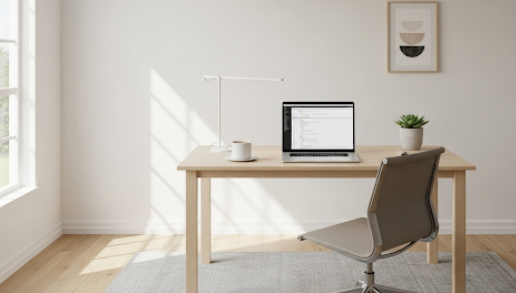
Eliminating Digital Distractions
Mastering Notification Management
Digital notifications are designed to distract and fragment your attention, making deep work nearly impossible. Protect your focus by taking control of notifications on all your devices.
Phone Notification Strategy:
- Turn off all non-essential app notifications
- Put your phone on “Do Not Disturb” during focus hours
- Only check messages at specific times (not constantly)
- Remove social media apps during work hours
- Use airplane mode for deep focus sessions
Computer Notification Control:
- Disable popup notifications for email
- Turn off social media notifications
- Install browser extensions that block distracting sites
- Only check messages at specific times
- Keep unnecessary browser tabs and applications closed
Email Management System:
Control your inbox, reduce email volume, and reclaim your time:
- Check email 2-3 times per day
- Use filters to automatically organize emails
- Unsubscribe from unnecessary newsletters
- Use auto-responders that explain your response time
Website and App Blocking Tools
Use technology to block distracting websites and applications during work hours when self-control isn’t enough.
Popular Blocking Tools:
- Cold Turkey – Complete computer blocking solution
- Freedom – Cross-platform blocking for apps and websites
- Forest – Gamified focus app that grows virtual trees
- RescueTime – Time-tracking with automatic website blocking
- StayFocusd – Chrome extension to limit time on distracting websites
Blocking Strategy Guidelines:
- Completely block social media sites during work
- Block news websites until scheduled break times
- Block entertainment sites like Netflix and YouTube
- Allow educational and work-related sites
- Create different blocking profiles for various types of work
Setting Boundaries with Family and Household
Communication Strategies That Work
Effectively managing family members and housemates is an important part of maintaining your home office productivity.
Setting Expectations:
- Communicate your work schedule and explain why interruptions are disruptive
- Set up visual indicators (like a closed door or sign) that signal work time
- Establish emergency-only interruption rules
- Schedule specific “family time” slots in your day
- Explain work duties to family members
Household Rules for Work Hours:
- Knock and wait for permission before entering
- Observe quiet hours during designated work times
- Define what constitutes an actual emergency
- Designate break times when interruptions are okay
- Respect work equipment and materials
Managing Pets and Children
Pets and children are lovely distractions when you’re trying to get work done from home.
Pet Management Strategies:
- Set up a pet bed or favorite blanket outside your office
- Use baby gates to keep pets out during focused work
- Provide toys and activities that entertain pets independently
- Schedule regular play time to meet their attention needs
- Utilize pet daycare and walking services for high-energy dogs
Child-Friendly Solutions:
- Create quiet activities for children near your workspace
- Schedule one-on-one time in your daily planner
- Arrange childcare during your most critical work hours
- Allow educational screen time for appropriate periods
- Set clear times when they can and cannot interrupt
Managing External Noise
Soundproofing Your Space
External noise from traffic, neighbors, or household activity can destroy your concentration. Implement both short-term and long-term solutions to noise problems.
Quick Noise Reduction Solutions:
- Replace thin curtains with heavy drapes
- Add thick rugs to floors to absorb sound
- Line walls with bookshelves for sound dampening
- Seal doors and windows with weatherstripping
- Add pillows and blankets to reduce echo
Permanent Soundproofing Options:
- Install acoustic wall panels on walls and ceiling
- Replace hollow doors with solid-core doors
- Insulate walls that adjoin noisy areas
- Install double-pane windows to reduce street noise
- Use fans or air purifiers to generate white noise
Sound Masking Techniques
When you can’t eliminate noise, you can mask it with more pleasant, consistent sounds.
Effective Sound Masking Options:
- White Noise Machines – Provide consistent noise to cover irregular sounds
- Nature Sounds – Rain, ocean waves, or forest sounds
- Instrumental Music – Classical, ambient, or focus playlists
- Brown Noise – Lower frequency than white noise
- Office Sounds – Simulated office environment sounds
Music Selection Guidelines:
- Choose instrumental music without lyrics
- Avoid songs with dramatic tempo changes
- Keep volume low enough to hear important sounds (phone, doorbell)
- Create different playlists for specific types of work
- Experiment with different genres to find what works best
Daily Routines That Support Focus
Morning Setup Rituals
The way you begin your workday determines how productive the rest of it will be. Create daily morning habits that prepare your mind and space for work.
Pre-Work Preparation Steps:
- Physical Space Check – Clean and organize your desk
- Technology Startup – Boot all devices and applications
- Day Planning – Review priorities and start with most important tasks
- Environment Adjustment – Set lighting, temperature and sound levels
- Mental Transition – Switch from personal to work mode
Morning Routine Timeline:
| Time Before Work | Activity | Purpose |
|---|---|---|
| 15 minutes | Clean and organize desk | Create physical order |
| 10 minutes | Start computer and check systems | Avoid technical delays |
| 5 minutes | Review daily priorities | Set mental focus |
| Work start time | Begin most important task | Capitalize on morning energy |
Break Management System
Taking regular breaks helps you maintain focus throughout the day. Structure your breaks to refresh your mind without losing momentum.
Effective Break Activities:
- Take a brief walk outside for fresh air
- Do simple stretching to relieve physical tension
- Practice deep breathing or meditation for a few minutes
- Have a healthy snack and drink water
- Look away from screens and focus on distant objects
Break Timing Strategies:
- Use the Pomodoro Technique (25 minutes work, 5 minute break)
- Take longer 15-30 minute breaks every 2-3 hours
- Take breaks before you feel tired or bored
- Set reminders to ensure you take necessary breaks
- Use breaks to transition between different types of work
End-of-Day Shutdown Ritual
How you end your workday impacts your evening relaxation and next day’s productivity.
Shutdown Routine Steps:
- Complete any urgent tasks or communications
- Review what you accomplished during the day
- Set priorities for tomorrow’s work plan
- Clean your desk and put materials away
- Turn off work technology and notifications
- Physically leave your workspace to signal the end of work time
Measuring and Maintaining Your Success
Tracking Your Productivity
Monitor your success to gain insights that help improve your distraction-free home office performance.
Productivity Metrics to Monitor:
- Hours of focused work completed each day
- Task completion versus goals set
- Frequency of interruptions or distractions
- Quality of work output
- Energy levels throughout the day
- Stress levels and job satisfaction
Tracking Tools and Methods:
- Time-tracking tools like Toggl or Clockify
- Simple daily journal with focus ratings
- Weekly reviews of accomplishments
- Regular assessment of workspace effectiveness
- Feedback on work quality from colleagues or clients
Continuous Improvement Strategies
Creating a distraction-free home office is an ongoing effort that pays dividends every day. Even when you get everything right, you need to periodically review and adjust your system to ensure it continues delivering the best results for you.
Monthly Review Questions:
- Which distractions am I successfully eliminating?
- What aspects of my office setup are working well?
- What new tools or techniques should I try?
- How have my work style or needs changed?
- Which adjustments could yield the most significant improvements?
Seasonal Adjustments:
- Modify lighting to adapt to changing daylight hours
- Adjust temperature control based on weather changes
- Reorganize storage to accommodate changing work projects
- Refresh décor and colors to maintain motivation
- Evaluate and upgrade technology as needed
Your Action Plan for Implementation
Building your distraction-free home office doesn’t have to happen overnight. Use this action plan to prioritize improvements and create your ideal workspace systematically.
Week 1: Foundation Setup
- Select and prepare your office location
- Declutter and organize the space
- Set up basic furniture (desk, chair, lighting)
- Establish initial boundaries with family/housemates
Week 2: Technology Optimization
- Arrange reliable power and internet connections
- Configure computer and essential software
- Set up notification blocking and website filtering
- Test all equipment and connections
Week 3: Distraction Elimination
- Implement phone and computer notification controls
- Address major noise issues with available solutions
- Create physical barriers and organization systems
- Establish daily routines and break schedules
Week 4: Fine-Tuning and Evaluation
- Track your productivity and focus levels
- Adjust lighting, sound and comfort settings
- Refine family communication and boundaries
- Plan ongoing improvements and maintenance
Conclusion: Your Path to Peak Home Office Productivity
Creating a distraction-free home office is one of the most important investments you can make in your career and overall life satisfaction. The strategies outlined in this guide provide a comprehensive roadmap for transforming your workspace into an environment that supports deep focus, maximum productivity and work-life balance.
Remember that there’s no perfect setup that works for everyone. You’ll need to adapt these systems to fit your unique situation, work requirements and personal preferences. Start with the fundamentals—location, furniture, and basic distraction elimination—then refine your setup as you learn what works best for you.
The key to long-term success is consistency and commitment to maintaining your distraction-free environment. There may be an adjustment period as you develop new habits and train family members to respect your workspace, but the payoff in increased productivity and improved remote work experience will be worth the effort.
Your home office should be a place where you do your best work, feel energized and inspired, and can clearly separate your professional and personal life. With the right setup and consistent focus on what you need to succeed at work, working from home can be more productive than you ever imagined.
Start by choosing one or two strategies from this guide and implementing them today. Small changes can lead to dramatic improvements in your ability to focus and get things done. Your future self will thank you for the time you invested in creating the perfect distraction-free home office setup.
